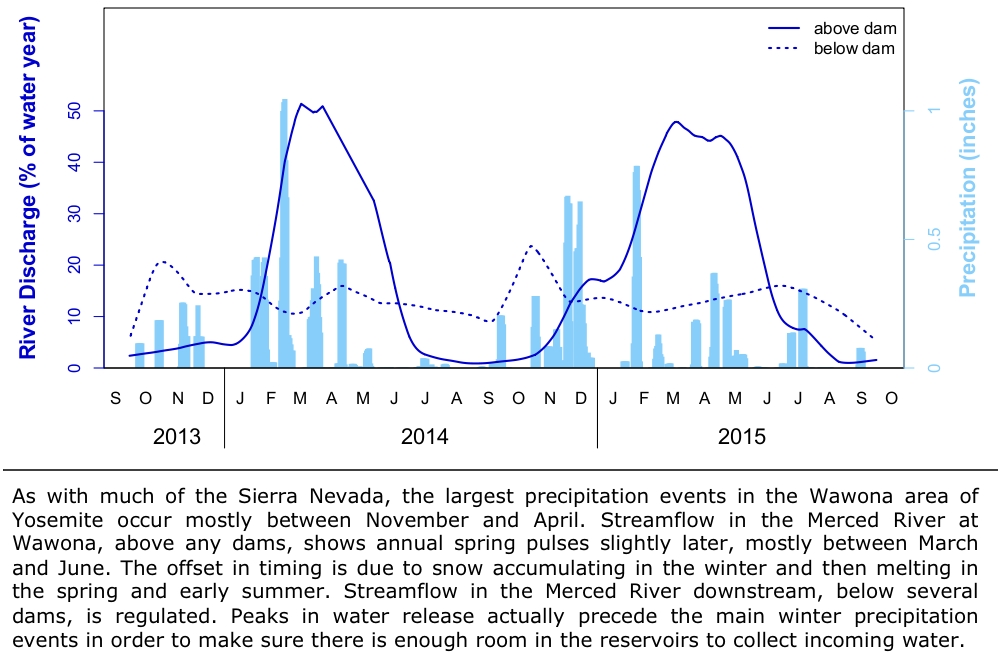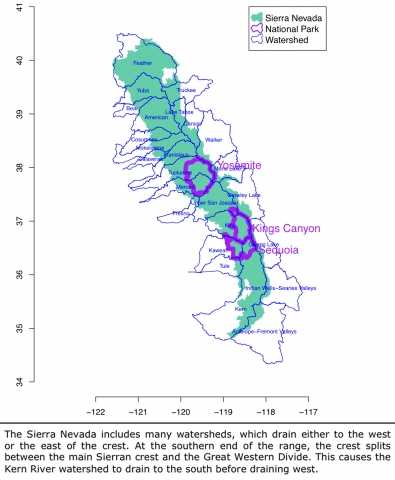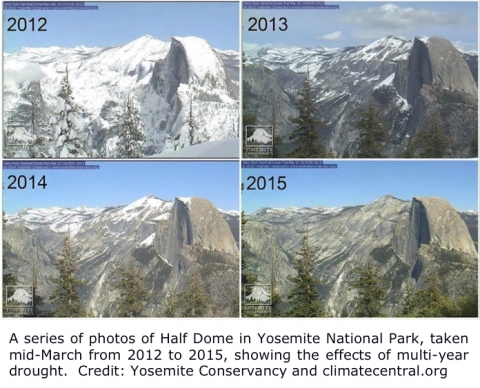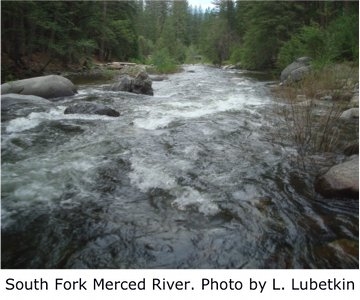Hydrology of the Sierra Nevada
Water
The impressive waterfalls, serene lakes, and luxuriant meadows of the Sierra Nevada could not exist without water. Indeed, water defines the planet itself, with about 70% of our planet's surface being covered with water. Yet only about 3% of Earth's water is fresh water, and of that, over 68% is frozen. Of the remaining fresh water, much is underground. This means that only 1% or so of the Earth's water is fresh, liquid, and easily available. Though the massive quantities of salt water are important to marine life on Earth, this impossibly small fraction of fresh water is precious in that terrestrial and freshwater species—humans included—rely on it to survive.
In the face of limited fresh water resources and the stresses of global climate change, water research is critical. Hydrologists study water and the surrounding landscape in order to understand the processes that control both water quality and quantity: where water comes from, how it moves through biotic and abiotic components of the environment, how much water enters streams, and how much is stored underground. This information helps us understand not only our precious water resource but also how ecosystems function, and allows us to predict how changes to the water cycle will affect the ecosystems and those, like us, that rely on it.
Sierra Nevada as a Source of California’s Water
About sixty percent of California's water supply originates in the Sierra Nevada, with Sierran snowmelt supplying 23 million Californians. At high elevations, snow accumulates layer by layer each time it snows. This persistent snowpack acts as a natural water storage reservoir. Once temperatures rise high enough in the spring, the snow slowly melts and releases water in what is known as the “spring pulse”. This meltwater travels downhill and flows into waterways. Water levels rise in streams and rivers, and waterfalls come to life. Some of the meltwater eventually flows to ecosystems at low elevations, supporting them through the long, hot, dry summers.
 |
While snowpack is the primary natural reservoir, mountain meadows can act as important secondary reservoirs. With their spongy soils full of organic matter, meadows absorb runoff during the spring pulse, reducing spring flooding downstream and storing water for later use. Meadows then slowly drain, extending the period of downstream flows during the summers. This is often what allows perennial streams to flow in summer.
In addition to natural reservoirs such as snowpack and meadows, California has numerous man-made reservoirs. These reservoirs serve a number of uses: supplying water for residential and agricultural use, reducing flooding, generating hydroelectric power, and providing recreational opportunities. However, dams significantly alter natural streamflow regimes. Plants and animals of Sierra Nevada and lowland ecosystems are adapted to the annual spring pulse, and may even require it to complete their life cycles. When rivers are dammed and regulated, water is no longer released at times important to their life cycles.
Sierran Watersheds
 |
The Sierra Nevada can be divided into a network of watersheds, or defined areas that drain water from high areas (mountains) to low areas (valleys). Yosemite National Park constitutes the upper reaches of the Merced River and Tuolumne River watersheds. Both the Merced and Tuolumne are designated Federal Wild and Scenic Rivers, and this status protects the water quality and free-flowing nature of these rivers. Tuolumne River's headwaters originate on the slopes of Mount Dana, and also stem from Yosemite's Lyell and Maclure glaciers. The Tuolumne River watershed encompasses the northern half of the park and includes the man-made Lake Eleanor and Hetch Hetchy reservoirs. The source of the Merced River is on the slopes of Mount Lyell and the Clark Range. This watershed is located in the southern half of the park.
Kings Canyon National Park constitutes the upper reaches of the Kings River watershed, while Sequoia National Park is split into the Kaweah River and Kern River watersheds. The Kern River is unusual in that it runs north to south, instead of east to west as the majority of rivers flow in the Sierra Nevada. The deep canyon of the Kern River creates two crests in the southern portion of the Sierra Nevada, south of the headwaters between the Kings River and Kern River: the main Sierran crest to the east and the Great Western Divide to the west. The Great Western Divide forms part of the boundary between Kings Canyon and Sequoia National Parks.
Extreme Events
California has experienced both droughts and floods throughout its history. Some of these have been quite extreme.
Droughts
Although we are highly dependent on water from Sierran watersheds, there is not always enough to support plant and wildlife habitat and supply people with water for drinking, agriculture, industry, recreation, and more. California has experienced many historic droughts, the most recent being a prolonged one with an alarmingly low snowpack between 2012 and 2015.
 |
In fact, on April 1 2015, the Sierra Nevada snowpack was only about 5% of its historic average, the lowest that has ever been recorded on this date. In times of drought, water levels in rivers, reservoirs, and lakes drop. Land in populated or farm areas begins to subside as people turn to groundwater resources and deplete local aquifers. Water that is usually set aside to preserve rivers, wetlands, and riparian habitat is sometimes reduced, and native fish and wildlife are jeopardized. In the dry heat of summer, vegetation dies and the landscape dries out even more than normal. Intense wildfires break out, leaving ash and woody debris in their wake. When rain finally does return, it makes mudslides out of barren ground that lacks the strong root systems that once held it in place. It washes the ash and debris into waterways, contaminating water supplies downriver.
Drought is not new to California and the Sierra Nevada, nor to western North America, in general. During the past 1,000 years, this region has experienced multiple severe, prolonged droughts known as megadroughts. Evidence of these megadroughts is present in several places, such as at Tenaya Lake in Yosemite. The tops of long-dead lodgepole pines visibly poke above the surface of this lake during much of the year. Lodgepole pines cannot grow in water-filled lakes, indicating that these trees grew during a time when Tenaya Lake was either empty, or close to it. Radiocarbon dating indicates that the submerged trees are actually from two different time periods, showing that there were two very long megadroughts in the not too distant past: ~1000-1100 and ~1200-1350 AD.
Floods
In addition to droughts, California experiences periodic floods. Extreme floods are often due to rain-on-snow events. As the rain melts existing snow, water that has accumulated through several storms is all released downstream at the same time, creating devastating downstream floods. While floods can be localized, the severe flood of 1997 affected watersheds throughout the Sierra Nevada. Recently, it has been recognized that the largest storms in California are usually caused by “atmospheric rivers”. Atmospheric rivers are localized regions (~400 km, or 250 miles, wide) with high water vapor and strong winds. These can cause extreme flood events when they make landfall.
Climate Change and Hydrology
And what of the future? The effects of climate change on total precipitation in the Sierra Nevada are uncertain and hard to predict because of the diverse topography and complex weather patterns of this mountain range. However, due to warmer winters, more precipitation is expected to fall as rain instead of snow. With a higher snowline, the size of the annual snowpack is expected to shrink, reducing the overall quantity of water that can accumulate in the Sierra Nevada. Additionally, there will likely be more winter “atmospheric river” rainstorms that increase winter streamflow and cause flooding and landslides.
 |
Reduced snowpack will also diminish the magnitude of the snowmelt-mediated spring pulse. Warmer temperatures will melt this snow earlier, causing water levels in rivers and streams to rise earlier in the season than usual. Though this will increase water availability early in the spring, it will then reduce water availability after the spring pulse wanes. An anticipated reduction in spring precipitation will amplify the water deficit during late spring and the ensuing summer months. Without the continuous supply of snowmelt that is provided by a large snowpack, summers will potentially be longer and drier, with less water available in rivers, streams, and aquifers. Drier summers are expected to lead to higher fire frequencies and increased fire severity. Accordingly, the overall area of land burned annually is expected to increase.
More information/Resources
California Department of Water Resources—Current Water Conditions: http://www.water.ca.gov/waterconditions/waterconditions.cfm
California Department of Water Resources Data Exchange Center—Hydrologic Data: http://cdec.water.ca.gov/
California Department of Water Resources—Sierra Nevada Snowpack is Virtually Gone; Water Content Now Is Only 5 Percent of Historic Average, Lowest Since 1950:http://www.water.ca.gov/news/newsreleases/2015/040115snowsurvey.pdf
California Department of Water Resources—Snowpack Survey Data: http://cdec.water.ca.gov/cdecapp/snowapp/sweq.action
Capital Public Radio—Climate Change Intensifying California Drought: http://www.capradio.org/articles/2015/08/20/climate-change-intensifying-california-drought/
Capital Public Radio—Drought Remains 'Very Serious' In California: http://www.capradio.org/articles/2016/02/04/drought-remains-very-serious-in-california/
Forest Service—Quantitative evidence for increasing forest fire severity in the Sierra Nevada and southern Cascade Mountains, California and Nevada, USA: http://www.fs.usda.gov/ccrc/library/biblio/1749
Glazner, A.F. and Stock, G.M. 2010. Geology Underfoot in Yosemite National Park. Mountain Press Publishing Company: Missoula, MT.
Los Angeles Times—California officials upbeat about snowpack, but long-range prospects are unknown: http://www.latimes.com/local/lanow/la-me-ln-snowpack-20151230-story.html
National Park Service—Facts about water: http://water.usgs.gov/edu/
National Park Service—Hydrology: http://www.nps.gov/yose/learn/nature/hydrology.htm
National Park Service—Streamflow Data for Merced and Tuolumne Rivers: http://www.nps.gov/yose/learn/nature/hydrology-data.htm
National Park Service Water Resources Division: http://www.nature.nps.gov/water/
NOAA—Atmospheric River Information Page: http://www.esrl.noaa.gov/psd/atmrivers/
Pacific Institute—The California Drought: http://www.californiadrought.org
State of California Sierra Nevada Conservancy—Sierra Nevada Watersheds: http://www.sierranevada.ca.gov/SNWatershed
Storer, T.I., Usinger, R.L., and Lukas, D. 2004. Sierra Nevada Natural History. University of California Press: Berkeley. Book preview: https://books.google.com/books?id=6h4q4dIcLb4C&printsec=frontcover#v=onepage&q&f=false
United States Geological Survey California Water Science Center—The California Drought: http://ca.water.usgs.gov/data/drought/drought-impact.html
United States Geological Survey National Water Information System: http://waterdata.usgs.gov/nwis




